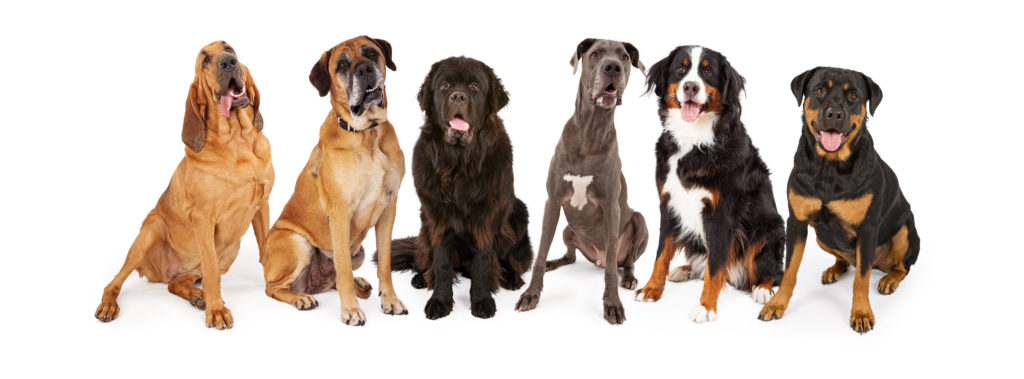Gastric Dilatation Volvulus (GDV)
One generally asks an emergency vet, “What is the most common or craziest thing you see?” And although this is an impossible answer, I would say one of our more exciting and truly urgent emergencies is something called, gastric-dilatation volvulus or GDV.
What is GDV?
GDV is the dilation or distension of the stomach, and the rotation of the stomach on its long axis. This twisting prevents the distension from resolving and thus causing an obstruction of outflow, but also pulls on the vessels that attach the stomach to the body wall. This then causes decreased return of blood to the heart that can result in cardiovascular shock.
Who is affected?
GDV is generally a disease of large and giant breed adult dogs. Both males and females are well represented, but breeds that seem to have a predisposition have deep chests such as Standard Poodles, German Shepherds, and Great Danes.

Predisposing Factors
Although there are no definitive predisposing factors, some include once daily feedings therefore causing rapid eating, stress, previous splenectomy or other large mass removal from abdominal cavity.
Clinical Signs? How Do They Present?
Signs at home of GDV include abdominal distension (especially rapidly developing distension), painful abdomen, non-productive wretching, gagging or hypersalivating, and even acute collapse.
On examination, these dogs are often noted to have painful distended abdomens with tympany (the swelling of the abdomen with air or gas). They often have elevated heart rates (some with abnormal heart rhythm secondary to cardiovascular shock), weak pulses, low blood pressure or perfusion, pale mucous membranes, or even difficulty breathing secondary to the large abdomen causing compression against the diaphragm.
What Happens if My Dog Comes in for Suspected GDV?
The first thing we will do is perform an examination and likely place an intravenous catheter. We’ll also take a blood sample for quick assessment tests including a blood gas, electrolytes, lactate level and red blood cell count, and perform a blood pressure check. We will most likely also take an x-ray to confirm the presence of GDV. Oftentimes, the stomach on x-rays appears like a C-sign or Popeye arm (also called a “double bubble”). We also perform an ECG (electrocardiogram) to look for arrhythmias (abnormal heart rhythm).
Often pain medication and intravenous fluids to help with perfusion (blood flow through the body) are given. Then based on the case, we may perform decompression of the dilated stomach in preparation for surgery. If surgery is needed, we will perform pre-anesthetic blood work including a complete blood count, chemistry profile, and coagulation panel. Most animals will also have thoracic radiographs performed to rule out concurrent problems.
Emergency surgery is the only treatment for GDV. We perform an abdominal exploratory a surgery to locate the abnormally rotated stomach in order to de-rotate it. If the stomach appears viable with no evidence of necrosis (dead or devitalized tissue from decreased blood supply) and has not ruptured, a gastropexy will be performed to tack the stomach to the body wall surgically to prevent recurrence of volvulus (torsion or twisting of the stomach) or GDV. The spleen will also be examined for problems and only removed if it is abnormal or the blood supply to the spleen is compromised. While in surgery, the remainder of the abdomen and its contents will be examined for abnormalities and action steps will be taken as needed.
Of course, complications of GDV that may be found during surgery include a ruptured spleen, torn vessels from the volvulus (rotating of the stomach) and internal bleeding, a devitalized stomach that needs to be partially resected (cutting out a portion of the tissue or organ), rupture of the stomach itself and leaking of intestinal/stomach contents. Unfortunately, the longer the GDV is present the increased risk of complications. It is also possible that there could be underlying cancer or even a foreign body.
Post-operatively, GDV dogs will stay in the hospital for at least 2-3 days and be monitored for pain, arrhythmias, bleeding, gastrointestinal motility or other complications. They are kept on fluids, pain medications, and anti-nausea medications. Some will need antibiotics (if infection is present, like aspiration pneumonia or a septic abdomen from a ruptured GI tract), while others will need medications to treat abnormal heart rhythms (usually ventricular tachycardia), and some may need packed red blood cell transfusions.
Prevention
Unfortunately, there is no definitive preventive measure to do to prevent GDV. In general, however, feeding large dogs two meals daily (instead of one), minimizing ingestion of large amounts of food, stress, and exercise after eating may help.
Gastropexy is a surgical procedure that can be performed prophylactically (as a prevention). This DOES NOT prevent dilation of the stomach, but it will prevent rotation/volvulus. This can be performed at the same time as a spay or neuter or concurrently with another abdominal procedure or as a single procedure.
Prognosis
Overall, the prognosis for survival from surgical GDV is about 85%. Sadly, poorer outcomes are usually related to the need for gastric resection, if the lactate level (a measure of perfusion) is very elevated and does not improve with the measure described above, the temperature and blood pressure are decreased, and if there is a significant delay in admission to a veterinary hospital.

Dr. Schildroth earned her veterinary degree from Ross University in 2005. After several years of working at Animal Medical Center’s Emergency and Critical Care in New York as an emergency and intensive care (ICU) doctor, she came to Friendship to work in the urgent care department.
